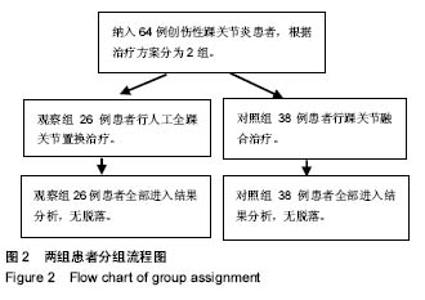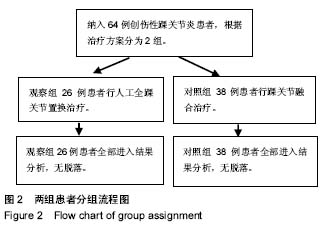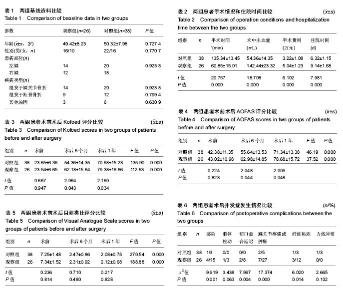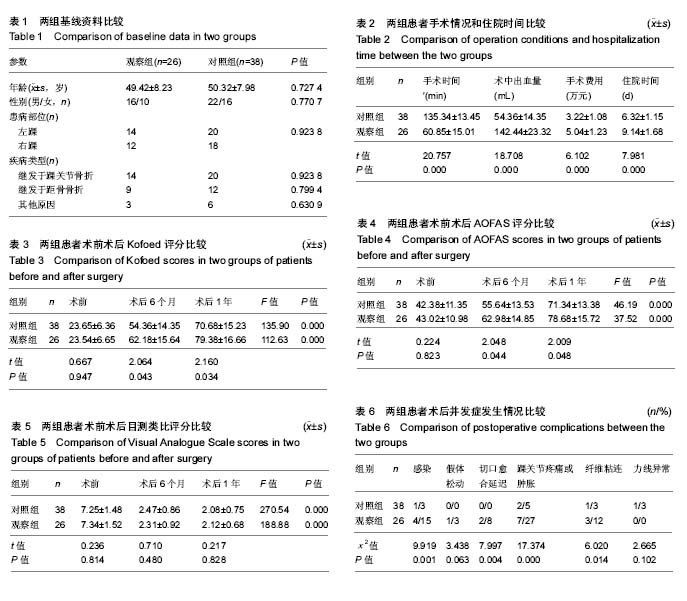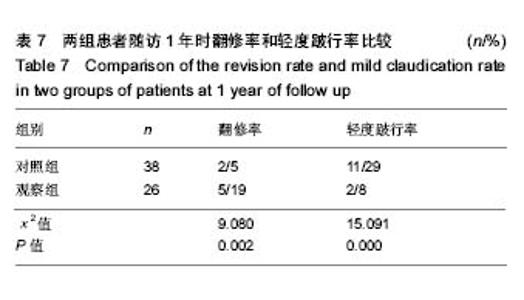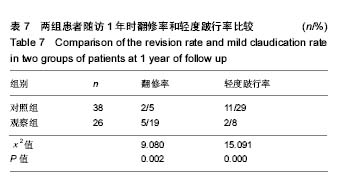| [1] 张博,王志为,任世祥,等. 踝关节融合术治疗踝创伤性关节炎的短期疗效观察[J].中国现代医学杂志,2015,25(4):56-59.[2] 董新春,何星飞,梁成盼,等. BTE Primus(RS)训练联合Maitland手法治疗踝关节创伤性关节炎的疗效[J]. 实用医学杂志, 2016, 32(7):1202-1203.[3] 韩明,张建中,杜宝在,等. 应用全踝关节置换术治疗晚期踝关节炎疗效分析[J]. 医学信息,2015,28(52):274.[4] Popelka S, Sosna A, Vav?ík P, et al. Eleven-year experience with total ankle arthroplasty. Acta Chirurgiae Orthopaedicae Et Traumatologiae Cechoslovaca. 2016;83(2):74.[5] 毛宾尧. 终末期踝关节骨关节炎,选择融合还是置换?[J]. 中国矫形外科杂志, 2015,23(13):1232-1233.[6] 刘先哲,陈朦村,杨述华,等. 人工全踝关节置换治疗踝关节骨病早中期效果观察[J].中华骨科杂志,2015,35(10):1055-1060.[7] 武勇,赖良鹏,王岩,等. 全踝关节置换治疗终末期踝关节炎疗效分析[J].中华骨科杂志, 2015, 35(7):699-706.[8] 张华峰, 稚君,马信龙. 人工全踝关节置换术[J]. 中华关节外科杂志:电子版,2013,7(2):250-253.[9] 周伟,黄松,陈敬有,等. 人工全踝关节置换与传统的踝关节融合术治疗踝关节骨关节炎的临床效果对比[J]. 检验医学与临床, 2016, 13(15):2139-2140.[10] 赵学良,路星辰,陈贤明,等. 创伤性踝关节炎:人工全踝关节置换术与踝关节融合术的早期疗效对比[J]. 第三军医大学学报, 2015,37(23):2391-2396.[11] 汪军,陈路.关节镜下踝关节融合术与人工全踝关节置换术治疗踝骨关节炎的随访研究[J]. 西部医学,2016,28(8):1125-1129.[12] 蔡培强,邵玉凯,李伟,等. 微创踝关节融合术治疗足踝创伤性关节炎的疗效观察[J]. 骨科, 2017,8(1):16-19.[13] 李为,李颖,周一新,等. 人工全踝关节置换术治疗踝关节骨关节炎的疗效分析[J]. 中华创伤杂志, 2011, 27(11):1012-1016.[14] Latham WC, Lau JT. Total Ankle Arthroplasty: An overview of the Canadian experience. Foot Ankle Clin North Am. 2016; 21(2):267.[15] Patton D, Kiewiet N, Brage M. Infected total ankle arthroplasty: risk factors and treatment options.Foot Ankle Int. 2015;36(6): 626-634. [16] 赵有光,俞光荣. 比较全踝关节置换术与踝关节融合术对患者体育运动休闲活动和功能结果的影响[J]. 中国矫形外科杂志, 2012,20(16):1483-1483.[17] 段小军,杨柳. 踝关节重度骨关节炎行关节镜下踝关节融合术的临床研究[J]. 第三军医大学学报,2015,37(3):220-224.[18] 欧乙利,刘雷. 创伤性踝关节炎的治疗进展[J]. 现代临床医学, 2016,42(3):238-240.[19] 唐映,冉春风,刘杰文. 玻璃酸钠联合磁振热治疗慢性创伤性踝关节炎的临床观察[J]. 湖南中医药大学学报, 2014,34(12): 48-50+54.[20] 栾彦军,白东昱. 踝关节融合治疗创伤性踝关节炎的疗效分析[J]. 实用骨科杂志,2015,21(7):653-656. [21] 武志伟,武士超. 创伤性踝关节炎行微创踝关节融合术的疗效观察[J]. 中国实用医药,2015,10(22):36-37.[22] 杨晓斐,蒋逸秋,李杨,等. 关节镜结合Ilizarov牵伸术治疗晚期创伤性踝关节炎[J]. 现代医学,2015,43(8):1052-1055. [23] 赖坤聪,钟华,孔禄生,等. 微创踝关节融合术治疗创伤性踝关节炎临床效果分析[J]. 青岛医药卫生,2015,47(5):330-332. [24] 赵学良,路星辰,陈贤明,等. 创伤性踝关节炎:人工踝关节置换术与踝关节融合术的早期疗效对比[J]. 第三军医大学学报, 2015, 37(23):2391-2396.[25] 余爱玉,郭林新,练克俭,等. 两种踝关节前路融合内固定方式治疗创伤性踝关节炎的疗效比较[J].中国骨与关节损伤杂志, 2015, 30(12):1287-1289. [26] 张慧超. 腓骨支撑辅助外固定支架行踝关节融合术对创伤性踝关节炎的治疗价值分析[J]. 中国卫生标准管理, 2016,7(3): 25-26. [27] 欧乙利,刘雷. 创伤性踝关节炎的治疗进展[J]. 现代临床医学, 2016,42(3):238-240.[28] 周松林,王上增,岳宗进,等. 踝关节镜结合中药外洗治疗20例创伤性踝关节炎的临床观察[J]. 中国民族民间医药, 2014,23(12): 27-28.[29] 郭玉祥,林福庆,林禄攀,等. 腓骨支撑辅助外固定支架行踝关节融合术治疗创伤性踝关节炎疗效观察[J]. 山东医药, 2014,54 (28):81-82. [30] 陈超雄. 早期创伤性踝关节炎的早期中药熏洗治疗[J]. 中国医学创新,2013,10(9):39-40.[31] 苏正兵,杨述华,段德宇,等. 踝关节镜在创伤性踝关节炎中的临床应用[J]. 临床骨科杂志,2013,16(4):439-441.[32] 聂涛. 踝关节镜治疗创伤性踝关节炎的疗效分析[J]. 微创医学, 2017,12(2):270-271.[33] 任爱国.创伤性踝关节炎采用踝关节镜治疗的方法及效果探讨[J]. 双足与保健,2017,26(10):130+134. |
